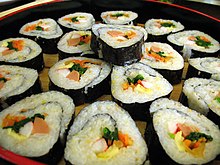This is an old revision of this page, as edited by Acuwer (talk | contribs) at 08:27, 26 March 2011 (Vandalism). The present address (URL) is a permanent link to this revision, which may differ significantly from the current revision.
Revision as of 08:27, 26 March 2011 by Acuwer (talk | contribs) (Vandalism)(diff) ← Previous revision | Latest revision (diff) | Newer revision → (diff)| Gimbap | |
 Platter of sliced gimbap Platter of sliced gimbap | |
| Korean name | |
|---|---|
| Hangul | 김밥 |
| Revised Romanization | gimbap |
| McCune–Reischauer | kimbap |


Gimbap or kimbap is a popular Korean dish made from steamed white rice (bap) and various other ingredients, rolled in gim (sheets of dried laver seaweed) and served in bite-size slices. Gimbap is often eaten during picnics or outdoor events, or as a light lunch, served with danmuji or kimchi.
Ingredients
The basic components of gimbap are rice, meat or other protein-rich ingredients, and a large variety of vegetables, pickled, roasted, or fresh. Traditionally, the rice is lightly seasoned with salt and sesame oil/perilla oil. Popular protein ingredients are fish cakes, imitation crab meat, eggs, and/or seasoned beef rib-eye. Vegetables usually include cucumbers, spinach, carrots, and danmuji (pickled radish). After the gimbap has been rolled and sliced, it is typically served with danmuji.
Varieties

Short grain white rice is usually used, although short-grain brown rice, like olive oil on gim, is now becoming more widespread among the health-conscious. Rarely, sweet rice is mixed in gimbap rice. Nowadays, kimbap's rice is many kind of black rice, boiled rice and cereals etc.
Gim is dried, pressed seaweed made from the edible species, laver. Gim may be roasted and seasoned with oil and salt, roasted but unseasoned, or raw and unseasoned. The oil used for roasting gim is traditionally sesame oil; however, today, corn and canola oils are also commonly used, especially with the pre-seasoned packs of gim sold widely in stores. Olive oil is also becoming more prevalent. For gimbap, the roasted, unseasoned variation is typically used.
Besides the common ingredients listed above, some varieties may include cheese, spicy cooked squid, kimchi, luncheon meat, or spicy tuna. The gim may be brushed with sesame oil or sprinkled with sesame seeds. In a variation, sliced pieces of gimbap may be lightly fried with egg coating.
Samgak gimbap (삼각김밥) is a triangle-shaped gimbap sold in many convenience stores in South Korea. Samgak gimbap also come in many varieties.
'Chungmu gimbap (충무김밥) is an unique gimbap made without any ingredients inside the roll. Originating from the seaside city of Chungmu, the rolls are thinner than regular gimbap and the surface is not brushed with sesame oil. Chungmu gimbap is tradtionally served with side dishes of kolddugi muchim (꼴뚜기 무침), sliced baby octupus marinated and fermented in a spicy red pepper sauce, and radish kimchi (무김치).
International familiarity
Gimbap was selected the top 100 foods of Korea for foreigners. Canada's largest urban weekly, straight.com, spotlighted gimbap in an article comparing it with sushi entitled "Korean kimbap rolls out of sushi's shadow". The article ends with this comment: "No need for soy sauce, wasabi, or pickled ginger: kimbap stands alone. It's a star waiting to be discovered."
Franchise
Many South Korean fast food restaurant franchises specialize in gimbap and noodles, and these establishments are extremely diverse in the cuisine they offer. Such chains include Gimbap Heaven (김밥천국), Gimbap Land (김밥나라), Gimgane (김家네), Gimbap and Spaghetti (김밥과 스파게티) and so on. These restaurants serve not only gimbap but also numerous other dishes, ranging from small snacks to pork cutlets, ramyeon, bibimbap, and other dishes.
References
- http://www.hantetsu.or.jp/essay/index.php?no=22 HANTETSU CLUTUAL FOUNDATION(韓哲文化財団 日本生まれのファーストフード)
- Yahoo! Korea dictionary 及び、NATE百科事典amp; amp; amp;v=42「김밥 (キムパプ)」 일본음식 김초밥에서 유래되었다(日本食の海苔巻きが由来)
- 東洋経済日報2009年5月1日 <随筆>◇キムパプ(ノリ巻き)礼賛論◇
- 2009年6月8日中央日報 ウナギの尻尾にこだわるアナタは韓国人
- /2009-0616-1749-47/www.nisshin-foods.co.jp/frozen/column/column05_1.html 日清フーズ株式会社 フードジャーナリスト 平松洋子「日本から韓国へ伝わった食べ物」
- 日本の太巻きが由来で、近代以降に韓国でも食べられるようになりました。 2005年5月13日 西日本新聞
- Kimbap, excerpt from Andrew J. Luxner's American English: A Teachers's Journey in Seoul, South Korea. Golden Hill Books, San Diego. ISBN 0-9760748-1-8
- ^ Template:Ko Gimbap at Doosan Encyclopedia
- Template:Ko Gimbap at Encyclopedia of Korean Culture
- Template:Ko Popularity of samgak gimbap, The Financial News, 2008-11-24. Retrieved 2010-06-25.
- Template:Ko Chungmu gimbap at Doosan Encyclopedia
- Template:Ko icon "우리나라를 대표하는 음식 100가지" Yonhap News, 2007-12-03.
- Carolyn Ali "Korean kimbap rolls out of sushi's shadow", Straight.com, June 7, 2007.
- Template:Ko Gimbap franchises popular, Edaily EFN, 2008-09-04. Retrieved 2010-06-25.
See also
External links
- Gimbap recipe at Chow Times
- Template:Ko Tuna gimbap recipe at Naver Kitchen